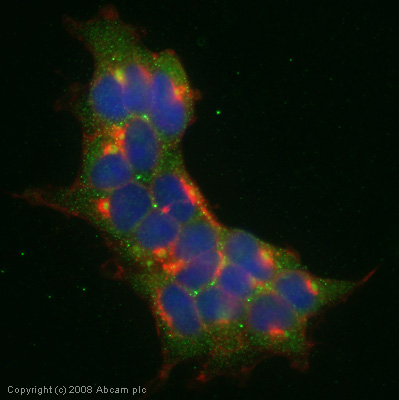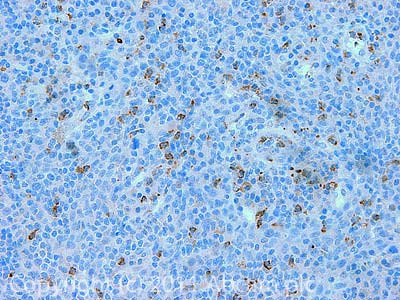
All lanes : Anti-NORE1 antibody (ab22770) at 1 µg/mlLane 1 : HEK293 cell lysateLane 2 : Mouse brain lysateLane 3 : HEK293 cell lysate with Human NORE1 peptide (ab23380) at 1 µg/mlLane 4 : Mouse brain lysate with Human NORE1 peptide (ab23380) at 1 µg/mlLysates/proteins at 20 µg per lane.SecondaryAlexa fluor goat polyclonal to rabbit IgG at 1/10000 dilution

ICC/IF image of ab22770 stained human Hek293 cells. The cells were methanol fixed (5 min), permabilised in 0.1% PBS-Tween (20 min) and incubated with the antibody (ab22770, 1µg/ml) for 1h at room temperature. 1%BSA / 10% normal goat serum / 0.3M glycine was used to block non-specific protein-protein interactions. The secondary antibody (green) was Alexa Fluor® 488 goat anti-rabbit IgG (H+L) used at a 1/1000 dilution for 1h. Alexa Fluor® 594 WGA was used to label plasma membranes (red). DAPI was used to stain the cell nuclei (blue).

IHC image of ab22770 staining NORE1 in Human Tonsil formalin fixed paraffin embedded tissue section, performed on a Leica BondTM system using the standard protocol F. The section was pre-treated using heat mediated antigen retrieval with EDTA (pH9, epitope retrieval solution 2) for 20 mins. The section was then incubated with ab22770, 5µg/ml, for 15 mins at room temperature and detected using an HRP conjugated compact polymer system. DAB was used as the chromogen. The section was then counterstained with haematoxylin and mounted with DPX.For other IHC staining systems (automated and non-automated) customers should optimize variable parameters such as antigen retrieval conditions, primary antibody concentration and antibody incubation times.


